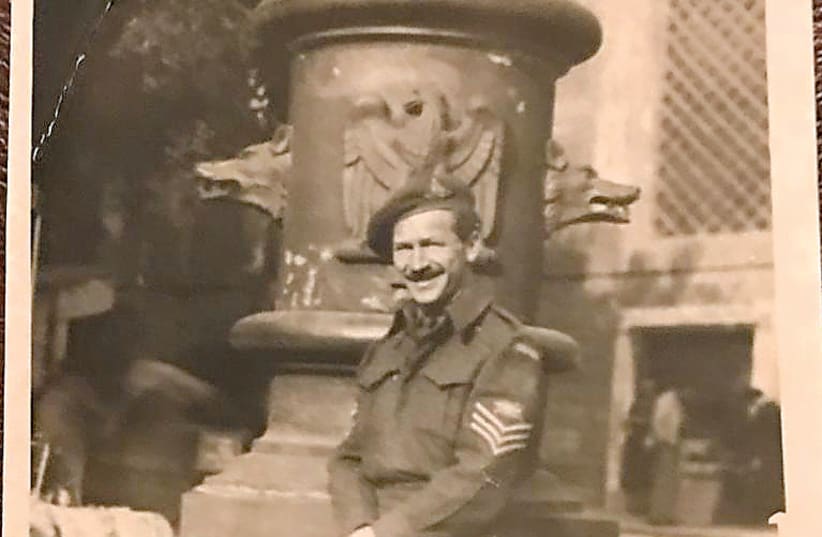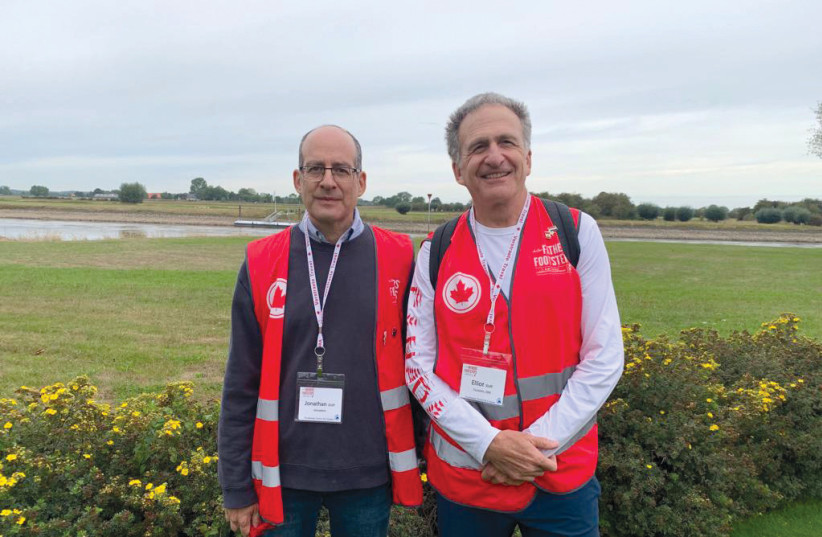Operation Cannonshot was launched at 16:00 on April 11, 1945. The soldiers of the 1st Canadian Division were tasked with crossing the IJssel River in Gorssel, Holland, cutting the retreating German forces in half, then pushing west toward Apeldoorn. It would be their last battle of the Second World War.
At 17:00, Sgt. Harry Bochner took a direct hit to the head from a piece of shrapnel, killing him instantly. Harry and his crew had retreated to a barn after coming under heavy mortar fire while trying to cross the river on a newly constructed pontoon bridge.
Lt. Gil Hunter heard about his friend’s death over the radio. He arrived just as Harry’s body was being sewn up in a blanket. Gil helped load Harry’s body onto a truck, which was then transported to a nearby meadow for temporary burial.
Seventy-seven years later, we (Elliott and Jonathan) were standing at the exact spot where our great-uncle was killed, alongside Gil’s daughter, Karen Hunter, and the property’s 85-year-old owner, Johan Wolters, who was a young boy on that fateful day. His family had taken shelter in the basement to escape the shelling. The house caught fire, so they ran to a nearby shed. Along the way, Johan saw Harry’s body being carried out of the barn. He still distinctly remembered the fatal head wound.
Remembering the Canadian liberation of the Netherlands during World War II
It was a surreal moment; one of many we experienced as part of “In Our Fathers’ Footsteps,” which was created by Karen Hunter to commemorate and memorialize the liberation of Holland by Canadian forces in the spring of 1945. It brought together a diverse group of 90 Canadians who had one thing in common: We all had relatives who had fought on Dutch soil. Almost none of us had met before. Most of us had no idea what to expect.
We were accompanied by a friendly group of high-ranking Dutch military veterans who provided historical background while navigating us through the forests, fields, and open countryside that Canadian forces had traversed, often under fire from the Nazi forces hiding in the woods.
Whenever we entered a town or village, led by the City of Apledoorn Pipes and Drums band, locals lined the streets, waving Canadian flags. Most were second or third generation from the war, yet were still amazed that Canadian soldiers had come across the world to free them from five years of Nazi occupation.
As we approached the village of Etten, the flags of Canada and the Netherlands, which had been attached to the town’s main windmill, flapped in the breeze. Upon our arrival, it seemed like the entire village had come out to greet us. We were serenaded by four choirs that were spread out across the downtown area. We mingled with the residents, who repeatedly thanked us for making the trip.
At the end of each day, the entire group gathered for dinner, listening to each other’s stories. We learned that most of our fellow participants had precious few details about their fathers’ wartime experiences. Many of the men had returned from the war with symptoms of post-traumatic stress disorder that were never properly diagnosed. If they spoke about the war, it was typically with their buddies at the Canadian Legion, not their families.
Ironically, although Harry was the only soldier from our group’s relatives who had been killed in action, we knew a great deal more about his military life. We never fully realized what a gift this was until we shared Harry’s story with our fellow participants.
We were given that opportunity at a special ceremony on Sunday, September 11, 2022, in a meadow near the town of Zutphen, where 11 Canadian soldiers, including Harry, had been temporarily buried. The organizers had placed 10 wooden crosses and one Magen David in the ground, along with pictures of the men who had been buried there.
There was a house next to the meadow. We were told that the little girl who lived there had placed flowers on the soldiers’ graves every day on her way to school. Incredibly, Antje van Geitenbeek, now in her 90s, still lives in the house. Although wheelchair bound, she participated in the ceremony. The organizers had prepared 11 bouquets of flowers, which she handed one by one to her grandchildren, who placed them next to the markers.
We (Elliott and Jonathan) then gave prepared speeches about Harry, sharing what we had discovered over the past 30 years.
Harry’s older sister, Mollie, was our grandmother. She never spoke about him. There were two framed pictures of Harry in our grandparents’ apartment – one of him in uniform, the other of his grave. That was all we knew, until one day, while rooting around in our grandfather’s infamous storage locker, Elliott found several boxes containing more than 1,000 letters that Harry had sent home. From the letters, we learned that Mollie wrote him a letter almost every day of the years he was away. He wrote back as often as he could, rarely missing a day.
The letters were a treasure trove of information, documenting Harry’s journey from training on Canada’s west coast and England, through the battlefields of Italy and finally Holland. He came off as a mature, witty, street-smart man who had a way with words.
The more we read, the more we wanted to know. An elderly cousin remembered him as a fun-loving guy, who worked in the fur trade but mostly liked to drink, gamble, and run around with women, much to the consternation of his strait-laced family.
Harry had enlisted at the rather advanced age of 30 with the Irish Regiment of Canada, led by Maj. Conn Smythe, a decorated soldier and legendary Toronto sportsman. While training in England as the sergeant of an anti-aircraft battery, Harry was selected to go to Italy for a six-month posting as an observer with the English 8th army.
The posting got canceled, but Harry and 213 other soldiers were already en route to Italy. He eventually made his way up the line, getting his first taste of action at Ortona in January 1943. He was put in charge of a 10-man crew.
Always chatty, entertaining, and informative, Harry’s letters got darker as the war progressed, alluding to the daily hell that he and his fellow soldiers endured: the constant noise, the cold, the dampness, and the pervasive stench of death. As the Canadians fought their way through the mountains of northern Italy, Harry scrounged to find food and shelter for his men. They went months without showering.
The letters were also quite profound. They told the story of someone who had come to a much deeper understanding about his own life, under the most difficult circumstances imaginable.
Elliott tracked down some of Harry’s fellow soldiers. They remembered him as a confident and trusted leader. He was older and much more worldly than his crew, most of whom were barely out of their teens. Many saw him as a father figure. Decades later, the gun crew driver, Jim Moore, was still in awe at the amount of time Harry spent writing home.
We also found several letters that had been written to the family after Harry was killed. They were heartfelt and sad. Our grandmother had kept them separate from the others, in a night table next to her bed. Jonathan read one of those letters at the ceremony. It was from the Jewish army chaplain, Isaac Rose, who had met Harry several times throughout the war and had officiated at his burial. In one of those bizarre “small Jewish world” sidelights, Jonathan knew Rabbi Rose in Jerusalem, sixty years after he had buried our great-uncle.
It was remarkable how many in the group were touched by Harry’s story. Several approached us after the speeches to talk further about it.
We then made our way to the city of Almen. We entered on foot, with our pipe and drum band leading the way. A woman carrying a large Dutch flag joined us and struck up a conversation. She asked who we were representing from our family. We told her about Harry. She expressed her sympathy, then said that he had died for a noble cause. Minutes later we were in the main square, surrounded by locals who plied us with food and drinks. We returned to Almen a few evenings later for a torch-lit remembrance ceremony next to a war memorial that is being built to commemorate 40 Canadian soldiers who had been temporarily buried in a nearby field. The names of the soldiers were read out. Three local schoolchildren then recited a memorial poem. Finally, the local orchestra played “O Canada” and the Dutch national anthem.
The following day, we visited the war cemetery at Holten. It is enormous, housing almost 1,400 graves of Canadian soldiers. The grounds are beautifully maintained, but it’s hard to digest the endless rows of uniform gravestones, each marking a young man who did not make it home.
The group organized a beautiful ceremony. Jonathan was asked to recite a Jewish prayer, which he adapted from the “El Male Rahamim” said for fallen IDF soldiers, for all the Canadian soldiers who had died to free the world of the Nazis. We brought Harry’s siddur on the trip, which had been sent home with his personal effects after he was killed. Jonathan held it while saying the prayer.
Following the ceremony, as the group fanned out across the cemetery, we made our way to Harry’s grave. In one of his letters, he had written about hoping to visit Palestine after the war. Since he never made it, Jonathan brought some earth and stones from Jerusalem to place on his grave. Elliott and his wife, Risa, brought stones from Canada, so Harry had a bit of both homes to signify our visit. We were sadder than expected leaving the cemetery.
Our trip wrapped up with a visit to Apeldoorn, home to the palace of Princess Margriet, who was born in Canada in 1943 after her family fled the Nazi occupation. She held a ceremony in a large courtyard, where she spoke quite warmly, then hosted us for high tea.
After nine days, it was time to head home. The trip had been meaningful and enlightening on so many levels. One final moment stuck with us. A day earlier, while visiting a new museum in the town of Nijverdal dedicated to the liberation of Holland, we noticed an original German-language map of the Weimar Republic hanging on one of the walls. On the far eastern edge of the map was the town of Lemberg, Austria – better known today as Lviv.
Our maternal great-grandparents, Mendel and Annie Bochner, had left their shtetl near Lemberg in 1900 with the hope of making a better life for their children, far from the poverty and persecution in Europe. Forty-five years later, their youngest Canadian-born son would give his life, fighting for freedom on the very continent that his family had fled. ■

